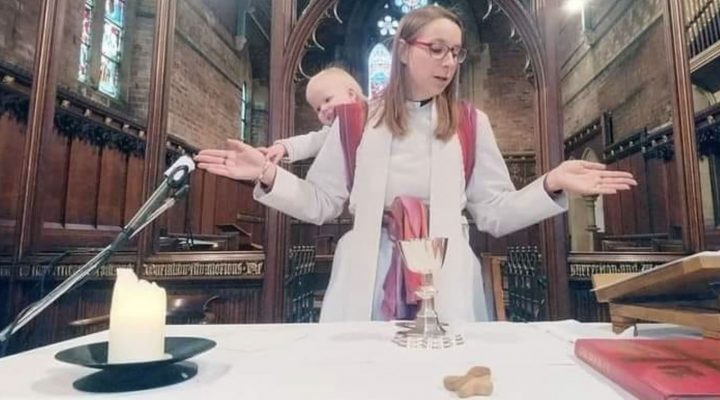On this International Day of Women and Inclusivity, I am inspired by an image that first came to me on Facebook. A pastor/priest is presiding at Communion, standing at the table with her infant child on her back in a baby carrier. She reaches out to bless the elements and so does the child.
Numerous complaints litter the Facebook post about how the woman might be disrespecting the priestly role or the ritual she is leading.

Eileen Campbell-Reed
I disagree completely on both counts.
Child raising and care has been defaulted to women for millennia. Of course there are many numerous exceptions, and a paradigm shift is under way. An image like this is a portal into that change.
Women are leading the church in greater numbers. Children should not only be seen but also heard. My own Baptist tradition is dedicated to faith that is anchored to an adult decision but can be nurtured in childhood. This is a tension I explore in my first academic book.
But many traditions believe in prevenient grace and believe the love of God and the grace in the elements of Communion can be extended to all people at all ages. Throughout the history of Christianity, this has been a consistent and sometimes contentious debate. But this child is not taking Communion — at least not in this image.
This child is one with its mother. And as one psychologist points out, there is no such thing as an infant singular, solo, alone. A baby must always be accompanied by its adults, its people, its caregivers. A baby without its beloveds and grownups and community soon perishes.
This woman is embodying the reality of life. How much we are interdependent on one another. That is how God made us.
She represents the millions upon millions of mothers who do their labor in a double way. They must include their children in their work for earning income and feeding their families. But those labors often remain hidden from the public eye. There is no one to simply leave the child with, so mothers take their children into their work.
“She represents the millions upon millions of mothers who do their labor in a double way.”
This priest makes visible what is often invisible.
In a very constructive and positive way, we can wonder about the gifts represented in this picture. What if the church made it their business, their priority, their top value, to let the children come into the ritual spaces of the church? Into all the spaces of church life?
That’s how Jesus put it. Caring for the “dignity, hope and joy of children” is how the Children’s Defense Fund mission statement puts it. Of course, men and nonbinary people are part of this equation, but Western culture has centuries of failing to recognize the fulsome complexity of what it is to be a mother and a laborer and a pastor/priest, and a full person.
This image brings together the fullness of women’s lives with the blessing of the church. And in the blessing and sharing of Communion, the church also receives the blessing of mother and child.
All of us were once babies. Someone cared for us enough that we grew into children, then teens, then adults. To be sure, some persons have been harmed by mothers and caregivers. Others see unfulfilled dreams and grief in this image. For everyone experiencing alienation or unfulfilled longing in an image like this, we can acknowledge losses and pray for one another’s healing.
What if we turned our attention and our priorities in the church toward a way that we might all live and work more holistically and with grace together? Including everyone fully in the beloved community? That’s what I’m thinking about this international women’s day.
Eileen Campbell-Reed serves as visiting associate professor of pastoral theology and care at Union Theological Seminary in the City of New York. She is founder and host of Three Minute Ministry Mentor, co-director of the Learning Pastoral Imagination Project, and author of Pastoral Imagination: Bringing the Practice of Ministry to Life.
Editor’s note: The image on which this post is based first appeared within a story published by The Church Times titled, “When Baby Comes, Too: The Challenges of A Reverend Mother.” No photographer is credited.


